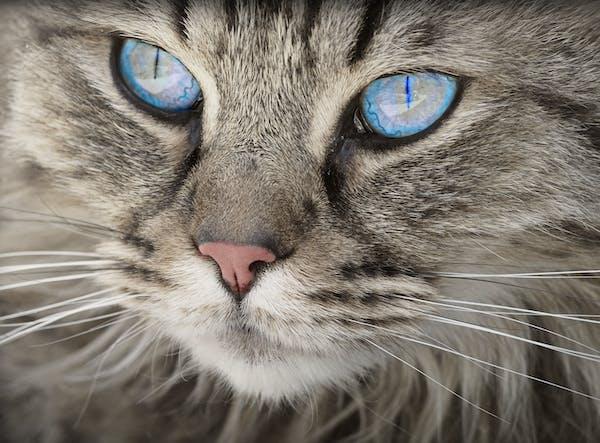

Eyes
Cats' eyes are remarkable sensory organs that play a crucial role in their survival, and understanding how they work, potential health issues, and proper care is essential for any responsible cat owner.
How Cats' Eyes Work:
Structure: Cats have large, round eyes with elliptical pupils that can vary in size based on light levels. They possess a layer of reflective cells behind the retina called the tapetum lucidum, which enhances their night vision by reflecting light back through the retina.
Vision: Cats have excellent night vision due to their tapetum lucidum, which gives their eyes a reflective, glowing appearance in the dark. They can see well in low light conditions and have a greater ability to detect motion than detailed objects.
Field of View: Cats have a wide field of view, approximately 200 degrees, which aids in detecting prey and potential threats.
Common Eye Health Issues in Cats:
Conjunctivitis: Inflammation of the conjunctiva, the pink lining of the eye, can result from infections, allergies, or irritants. Symptoms include redness, discharge, and squinting.
Corneal Ulcers: These are painful sores on the outer surface of the eye and can occur due to injuries, infections, or underlying diseases. Squinting, tearing, and sensitivity to light are signs of corneal ulcers.
Cataracts: Cataracts are a clouding of the eye's lens, leading to decreased vision. While they can be genetic, they may also result from aging or underlying health conditions.
Glaucoma: This condition involves increased intraocular pressure, which can lead to severe pain and vision loss. Symptoms include squinting, dilated pupil, and a cloudy eye.
Cherry Eye: Cherry eye occurs when a gland in the nictitating membrane (third eyelid) prolapses, causing a red mass to protrude from the corner of the eye. Surgery is often required for treatment.
Preventive Measures:
Regular Veterinary Check-ups: Schedule annual or bi-annual check-ups with a veterinarian to monitor your cat's overall health, including their eyes.
Good Nutrition: Feed a balanced diet rich in essential nutrients to promote overall health, including ocular health.
Regular Eye Exams: Schedule annual check-ups with a veterinarian to detect issues early. Keep an eye out for any changes in their eyes.
Maintain Good Hygiene: Clean the area around the eyes regularly to prevent infections.
Avoid High-Risk Activities: Protect your cat from potential eye injuries, especially if they're outdoor cats. Obviously, they are naturally into everything, so just keep an eye out (no pun intended) for anything unusual.
Environmental Safety: Keep your home safe to prevent eye injuries. Remove hazardous objects that your cat could bump into, and protect them from potential dangers, such as toxic chemicals and sharp objects.
Treatment and Care: The treatment for cat eye problems varies based on the specific issue, but it can include:
Medication: Antibiotics, anti-inflammatory drugs, or antiviral medications as prescribed by a veterinarian.
Surgery: May be required for more serious issues like cataracts or corneal ulcers.
Lubrication: Artificial tears or ointments can help with dry eyes.
Managing Underlying Conditions: Treating any underlying conditions contributing to eye problems.
What to Look Out for as a Responsible Owner:
Changes in Behaviour: If your cat is squinting, pawing at its eyes, or showing signs of discomfort, it's time to investigate.
Eye Discharge: Check for any unusual discharge, such as excessive tearing, pus, or blood. As tears are in permanent production, some crusting around the eyes is normal, but if your cat's eyes are watering excessively or the discharge seems to be very thick and mucus-like it can be a sign of something wrong.
Cloudiness or Changes in the Eye: Cataracts or other issues can cause changes in the appearance of the eye.
Blinking Frequency: Rapid blinking can indicate discomfort or pain.
Redness and Swelling: These signs may be indicative of inflammation or infection.
Vision Changes: If your cat is bumping into objects or seems disoriented, it may have vision problems.
Understanding your cat's eye anatomy, how they work, and being vigilant about their eye health is essential for responsible cat ownership.
Regular check-ups and quick action in case of any eye issues can help keep your feline friend's vision healthy and clear.